Solution
Results
CSIRO needed to gain cellular coverage in well-insulated areas of the new, 4-story building that’s 150,000ft² (14,000m²) and has over 5,000 employees.



Keeping people connected through the world’s smartest cell phone signal boosters, public safety communication systems, private networking solutions, and HPUE devices. Powered by proprietary IntelliBoost® technology.
16550 West Bernardo Drive
Building 5, Suite 550
San Diego, CA 92127
+1 (858) 485-9442
[email protected]
©2024 Nextivity, Inc.